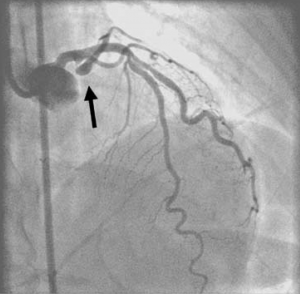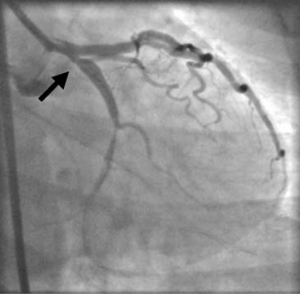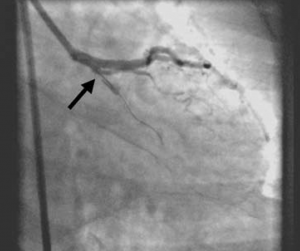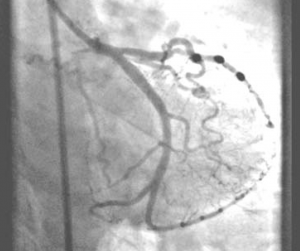The presence of severe vessel tortuosity, extreme angulation of side-branch ostia, stent jail, or lack of control at the interface of chronic total occlusions can result in percutaneous coronary intervention failure or complications. The Venture™ wire control catheter is a new catheter system designed to facilitate tip direction of a standard 0.014” guidewire. The properties of this system are discussed in this article along with an example of its use in practice.
Introduction
Percutaneous coronary intervention (PCI) has become the most commonly used invasive treatment for patients with coronary heart disease (CHD).1 Despite great advances in equipment technology, the presence of severe vessel tortuosity, extreme angulation of side-branch ostia, stent jail, or lack of control at the interface of chronic total occlusions (CTO) can result in procedural failure or complications.2 In the treatment of a CTO, for instance, studies suggest that the most common cause of failure was inability to pass the guidewire across the occlusion.3 In these situations, the ability to re-configure working tip angulations of guidewire and catheter to suit varying anatomy of the target vessels and lesions may result in better support and more precise control in the delivery of PCI equipments.
Deflectable-tip guidewire systems have been produced but have had limited success. The first in vivo deflecting tip wire (Versaflex; Medtronic, Minneapolis, MN) could be deflected in one direction to accommodate anatomical variations, but the stainless steel construction resulted in undesirable tip rigidity. A later-developed 0.014” stainless steel wire with a 5 mm deflecting tip (Pilot; USCI Bard, Billerica, MA) was more utilised but ultimately had similar faults.4 Neither device is currently available and their failure to survive may, in part, be due to the fact that the tip deflection system did not prove durable in vivo, the transition from deflection joint to support zone was abrupt and the ergonomics of handle design and position were less than ideal. In addition, their intrinsic internal activation system inevitably changed the performance characteristics of the wire tip compared with highly refined modern guidewires, which interventional cardiologists have now become familiar with and generally prefer.
In this report, we describe our experience with a new catheter system designed to facilitate tip direction of a standard 0.014” guidewire. The Venture™ wire control catheter (St Jude Medical, Minnetonka, MN) is designed to provide steering control and back-up support to help steer any 0.014” approved guidewire through challenging coronary anatomy while providing both guidewire support and intracoronary adjustment of the guidewire tip angle.
Practical aspects
The Venture™ is a low profile, 6 Fr-compatible, flexible, torqueable, support catheter with a mechanically activated atraumatic deflectable tip that can bend up to 90 degrees. The flexible three-layered coiled torque shaft provides precise controlled torque translation from proximal rotating hub to distal tip, allowing this to be precisely directed. The 140 cm over-the-wire Venture™ catheter system can be used with all approved 0.014” guidewires and the current system requires a 300 cm guidewire or the facility to exchange over a standard 190 cm wire.

The guidewire tip is shaped at the discretion of the operator and then loaded into the lumen of the Venture™ catheter. The Venture™ catheter and guidewire can then be introduced as a single unit into any approved angioplasty guide catheter of at least 6 Fr before being advanced to the coronary artery. Alternatively, the Venture™ catheter can be advanced over an exchange length guidewire. Flexion of the distal tip of the Venture™ is achieved by clockwise rotation of the thumb wheel on the external handle, which permits a pull wire within the catheter shaft to provide tension to one side of the catheter relative to the other. The 8 mm distal tip is radiopaque and is the only compressible part of the catheter permitting flexion. The catheter tip can be further rotated in the circumferential plane by rotation of the entire external handle providing fine control of the guidewire. In addition, the entire assembly can be advanced or retracted within the vasculature as required.
Technique
The ability to change direction of current fixed-shape guidewire tip angles enables more precise wire control in the engagement of target vessels/lesions with difficult take-off angles and helps guidewire advancement around bends as well as steering the guidewire away from dissection planes. In addition, the Venture™ catheter provides more effective back-up support for guidewires to traverse complex lesions including CTOs.

The Venture™ catheter can be an extremely useful adjunct when accessing a side branch (figure 1). The preferred technique often involves several manoeuvres, including:
- Advancement of the catheter distally.
- Guidewire withdrawal into the catheter.
- Applying deflection at the point of the bend fluoroscopically.
- Gentle rotation of the catheter.
- Withdrawal of the catheter tip to the ostium
of the side branch with further deflection. - Subsequent guidewire advancement.
The Venture™ catheter may then be advanced over the guidewire, as necessary, to assist if the vessel is tortuous, although the flexion mechanism should be deactivated to enhance trackability. Once the guidewire is correctly placed in position, PCI can continue as normal.
There are some limitations to the Venture™ catheter system. The 0.0175” internal diameter offers a rather low clearance for friction-free 0.014” guidewire manipulation and the exchange from a soft to stiff wire is not smooth when the catheter tip is in a deflected position. Also, the ability to change guidewire tip angle is diminished with stiffer CTO wires (e.g. Confienza™).
Case report

A 49-year-old Asian lady with hypertension, dyslipidaemia and familial premature atherosclerosis presented with chronic exertional angina. Figures 2a and 2b show a sub-totally occluded proximal circumflex artery (LCx) that had retrograde filling from branches of the right coronary artery.
PCI on the LCx was attempted using a selection of 6Fr guide catheters (Voda 3.5 and 3.0 left, Judkins 3.5 left and Amplatz left-2) and guidewires (BMW, Choice PT floppy and Crosswire). However, the ostial lesion could not be crossed as the LCx arose at a 90 degree angle from the left main stem (LMS) and the guidewires persistently prolapsed into the left anterior descending artery (LAD). The procedure was abandoned but the patient returned six weeks later for a second attempt using the Venture™ wire control catheter.

In this case, the LCx was intubated with a 8Fr Voda 3.0 left guide catheter and an exchange length (300 cm) Choice PT floppy guidewire and VentureTM catheter advanced to the LMS. The tip of the Venture™ catheter was angled towards the LCx, allowing the guidewire to advance to the distal vessel (figure 3). The ostial lesion was pre-dilated with a 2.0 x 12 mm balloon and bare-metal stents were deployed to mid-vessel (3.0 x 16 mm Liberte) and ostium (4.0 x 12 mm Liberte). The final result was excellent (figure 4).
Conclusions
Vessels that have difficult take-off angles or extreme proximal tortuosities often impinge on the ability of guidewires to traverse severe or complex lesions in the vessel, which may result in procedure failure. In addition, the length and degree of curve required to enter the origin of an angulated or tortuous vessel may make subsequent crossing of distal lesions within the vessel impossible.

The Venture™ catheter system offers the ability to steer the tip of the operator’s choice of guidewire in all planes with both flexion and rotation, enhancing the chance of successful passage across the lesion. The catheter tip is relatively atraumatic, highly trackable and could prove an invaluable device in PCI of unfavourable coronary vasculature.
Conflict of interest
None declared.
Key messages
- Percutaneous coronary intervention (PCI) is the most commonly used invasive treatment for patients with coronary heart disease
- Complicated coronary vasculature can make PCI difficult and potentially lead to procedural failure
- The Venture™ wire control catheter is a low profile 6 Fr-compatible, flexible, torqueable, support catheter with a mechanically activated atraumatic deflectable tip that can bend up to 90 degrees
- The Venture™ wire control catheter could prove an invaluable device in PCI of unfavourable coronary vasculature
References
- Dawkins KD, Gershlick T, de Belder M et al.; on behalf of the Joint Working Group on Percutaneous Coronary Intervention of the British Cardiovascular Intervention Society and the British Cardiac Society. Percutaneous coronary intervention: recommendations for good practice and training. Heart 2005;91(suppl VI):vi1–vi27.
- Wilensky RL, Selzer F, Johnston J et al. Relation of percutaneous coronary intervention of complex lesions to clinical outcomes (from
the NHLBI Dynamic Registry). Am J Cardiol 2002;90:216–21. - Noguchi T, Miyazaki S, Morii I, Daikoku S, Goto Y, Nonogi H. Percutaneous transluminal coronary angioplasty of chronic total occlusions. Determinants of primary success and long-term clinical outcome. Catheter Cardiovasc Interv 2000;49:258–64.
- Myler RK, Tobis JM, Cumberland DC, Hidalgo B. A new flexible and deflectable tip guidewire for coronary angioplasty and other invasive and interventional procedures. J Invas Cardiol 1992;4:393–7.
